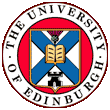Structure Formation in the Early Universe
Here at the IfA, Dr. Avery Meiksin along with post doc Eric Tittley and graduate student Simon Reynolds are exploring structure formation from galaxies to large scales in the early universe (100 > z > 1.5) using numerical simulations, with emphasis on the baryonic matter.
Goals
- Explore the What? When? and How? of Reionisation.
- Understand origin and distribution of IGM metals.
- Investigate role of entropy injection in young Universe.
Why?
- Most of the gas in the universe is in large scale structure.
- Structure growth is in a quasi-linear growth phase hence sensitive to cosmology.
- Galaxy formation, a "Holy Grail" of Astronomy, occurs in structure.

The physics of structure formation is complicated
- Gravitational collapse leads to galaxy formation.
- Galaxy formation leads to ionising radiation and heating.
- Winds disperse metals and further heat the gas.
- The heating from radiation and winds impedes galaxy formation.

Observing high-redshift structure
QSO absorption spectra allow us to measure the state of the intervening (mostly) ionised gas.


Scattering of CMB photons by free electrons permits measurement of the optical depth of the ionised gas.

Mapping of the redshifted 21 cm line of HI reveals the structure of reionisation.

Work at University of Edinburgh's Institute for Astronomy
At the IfA, we have developed a unique code with which to study the epoch of reionsation. We have written a radiative transer (RT) code that determines not only the correct ionisation fractions, but also the temperatures.
Coupling the radiative transfer code to a particle-mesh (PM) code allows us to model reionisation in the early universe.

Movies
Movies of an ionisation front passing through a 25 h-1 Mpc (comoving) volume from z=8 to 3.
A Quasar in the centre of a 35 h-1 Mpc comoving volume. Gridding by undergraduate student Calum Brown.
Unless explicitly stated otherwise, all material is copyright © Eric Tittley
